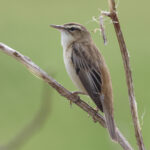A Private Tour in North Norfolk today. It was to be a different day to normal, as we were planning to try to catch up with a selection of the scarcer winter visitors along the coast, as well as aiming to see as many different species as possible. We would need to cover quite a bit of ground, a bit of a whistle-stop tour of North Norfolk. After a grey start, it brightened up for a time during the morning, though it was rather breezy all day. We were forecast rain in the afternoon, and it arrived a bit earlier than forecast, but it didn’t stop us having a great – and very successful – day out.
It was an early start. As we drove up towards the coast, it was just getting light. We stopped off on the way, just in time to catch a Barn Owl out hunting still, before it went in to roost. An over-wintering Chiffchaff was calling from some trees nearby and the first Pink-footed Geese flew over, heading inland to feed.

At our next stop, as we walked out beside the grazing marshes, the first bird we saw was another Barn Owl out hunting. It flew round over the field, disappeared over the bank, then came back again and did a couple more circuits before landing down in the grass. It stayed there for a minute, looking round, before flying off round the trees beyond. It was still early and rather cold here, and there didn’t seem to be many other birds awake yet. A Marsh Harrier quartered the grazing marshes.
We looped round to Cley and headed down to the beach. There has been a large flock of scoter on the sea here in recent days, but there was no sign of them this morning. While we were scanning, we noticed a flock of small birds fly up from the beach away to the east. Snow Buntings. We walked down along the shingle for a closer look.
The Snow Buntings were very flighty, flying up well before we got anywhere near, and heading further down the beach. Thankfully, as we got to where they had been feeding, they flew back in and landed on the shingle right in front of us. They were remarkably well camouflaged against the stones, but they were really close so we got a good really look at them. We counted at least 70 of them in the flock here today, although it was hard to get an accurate figure as they wouldn’t stop moving!

While we were walking out for the Snow Buntings, we noticed a couple of gulls on the beach beyond. One was rather pale, and through the scope we could see it was the juvenile Glaucous Gull which has been hanging around here for a few days now. It has been feeding on dead seals washed up on the beach in last week’s storms, but this morning it was loafing. When we got down the beach, it was lying down on the beach, dozing. Still, we could see its very pale wing tips, much paler than the rest of the bird.
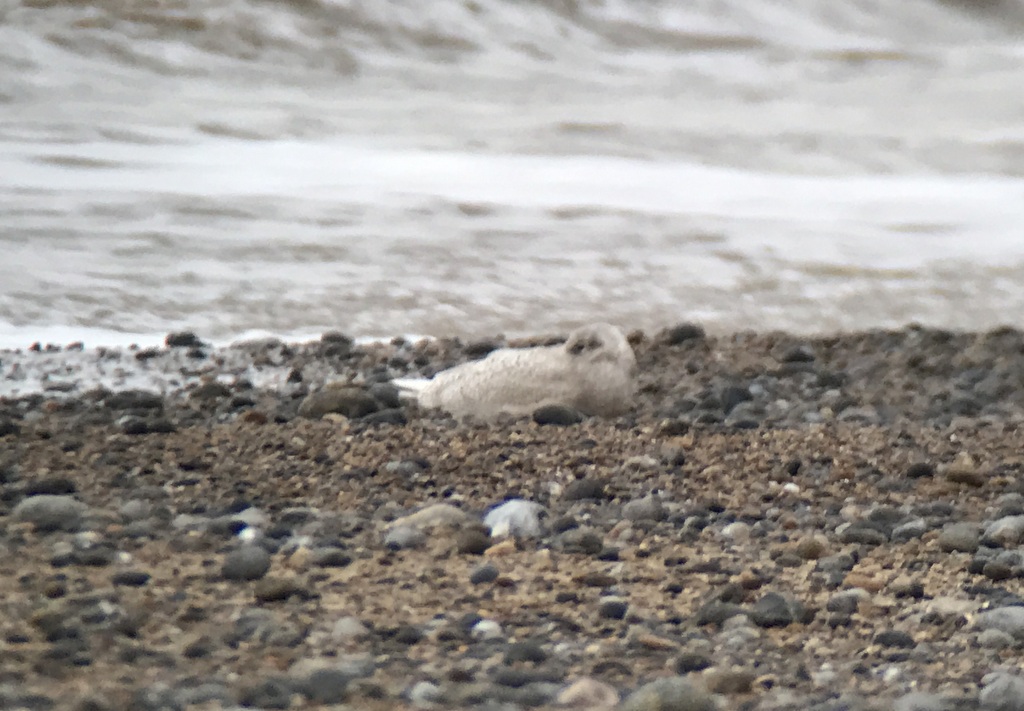
Looking out across North Scrape, there were several Shelducks scattered around the water. A small group of ducks closer to the front were all Pintail, busy upending in the shallows. As we turned to walk back, several groups of Brent Geese flew in, from the direction of the harbour where they had presumably roosted last night.
We stopped to have another scan of the sea when we got back to the beach car park. There was still no sign of the scoter flock, but we did pick up a Red-throated Diver on the water just offshore. A Guillemot flying past was a nice bonus too.
It was a very successful stop at Cley, but we had a busy day ahead and no time to explore the rest of the reserve today, so we moved on. We headed inland again next, to check out some farm buildings where there are sometimes Little Owls. It didn’t feel like a particularly good day to be looking for them – given the grey skies and wind – and they have not been very active recently anyway, but we thought we would have a quick look. Our luck was in. The first place we stopped, we spotted a Little Owl. It had found a sheltered spot, out of the wind, in the window of an old barn.
We moved on again, heading back across and down to the coast at Holkham. As we drove up along Lady Anne’s Drive, we could see more Pink-footed Geese out on the grazing marshes. There were lots of Wigeon out on the grass too, and a scattering of Teal around the pools.
Parking at the north end of the drive, we could see a large flock of Brent Geese feeding in the field next door. Most of them are Dark-bellied Brents, the regular form here which breeds in Siberia and spends the winter along the coast here. Looking through them carefully, we found one which was noticeably paler below, brighter white on the flanks and round under the belly. It was a Pale-bellied Brent, a scarce visitor here.
There was also a darker goose with them, with a more striking white collar than the others – one of the regular Black Brant hybrids, the result of a past pairing between a Black Brant (the third form of Brent Goose, which normally winters along the Pacific coasts) and one of our Dark-bellied Brents. They are regular here, with as many as three in the Wells / Holkham area, returning to the same fields each winter. A pitfall for the unwary, they are often misidentified as pure Black Brants.
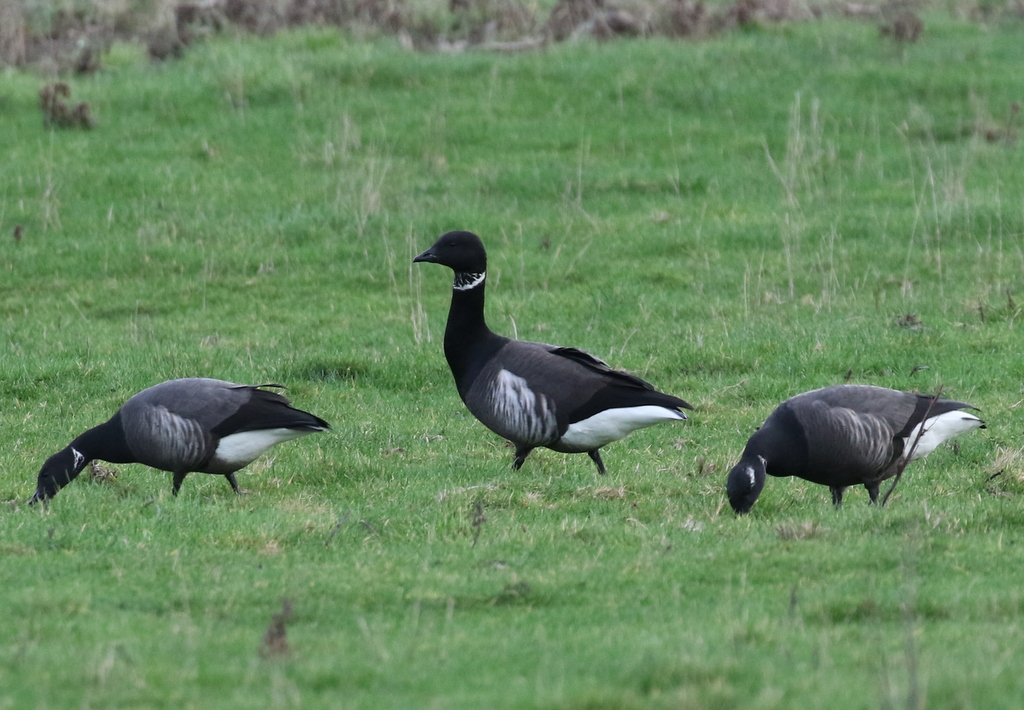
A careful scan around the field produced a Grey Partridge, over towards the back. We could see its orange face and the distinctive dark kidney mark on its belly through the scope. We were heading out for the beach, so we cut through the trees, which were quiet today.
Since Christmas, the Shorelarks have been more elusive and spend a lot of their time feeding in the taller saltmarsh vegetation where they can be hard to see. Thankfully, as we walked out towards the cordon, someone had already found them and a small group of people had gathered to watch them.
The Shorelarks were only a few metres out from the path, but were still very difficult to see, creeping around in the vegetation. Thankfully, one stopped to preen on a little tussock and we were able quickly to get it in the scope. We could see its bright yellow face and distinctive black mask. Once we had found one, we could see there were more around it. Probably there were all 26 here, but we could see no more then 3-4 at any time and at times it was hard to see any at all!
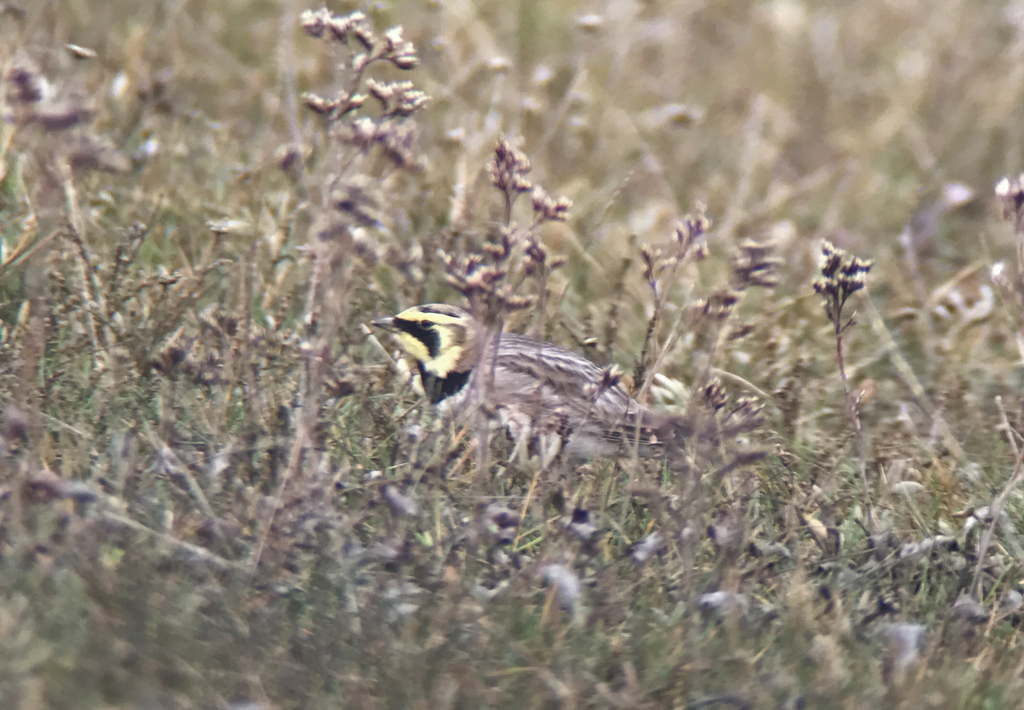
Continuing on to the cordon, a flock of small birds flew up from the edge of the sandy path ahead of us, and landed back down again. More Snow Buntings. There were eighteen here now (they were joined by another two when we walked back), the flock having declined since Christmas as some of the birds seem to have moved on. They are very obliging though, and let us walk right past them without flying off.
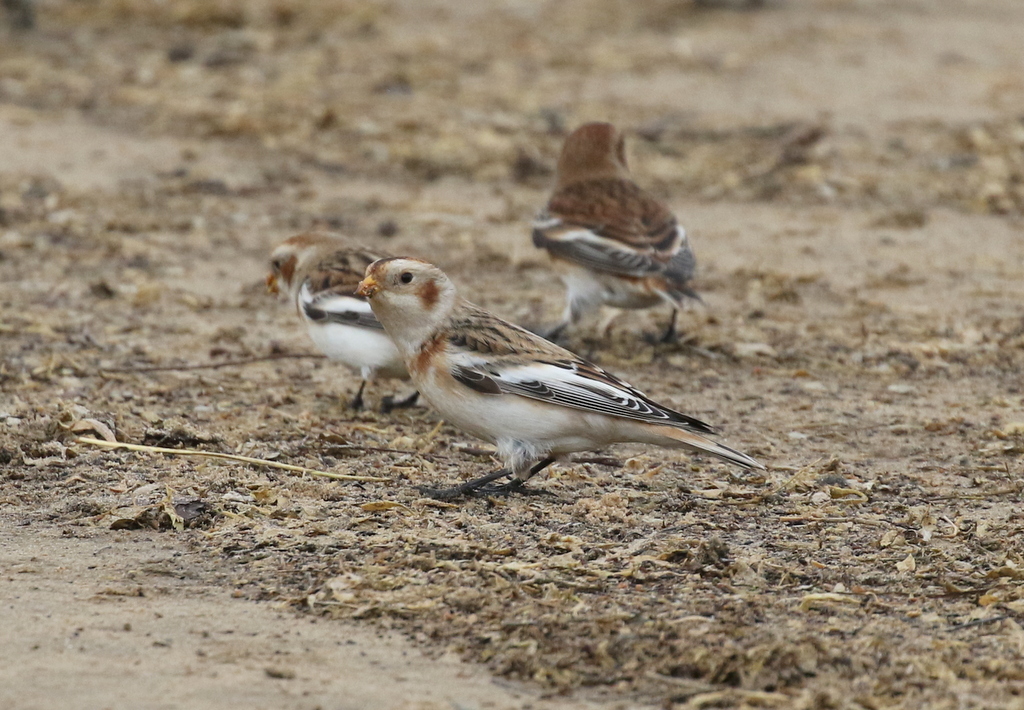
The sea at Holkham has been quiet in recent days, but we thought we would try our luck here, as we were doing so well. There were several Cormorants out on the sandbar just offshore, drying their wings. A few Oystercatchers were out there too, and a small flock of Sanderling whirled round and landed in with them.
Having set up the scope, we found it happened to be pointing right at a small party of Red-breasted Mergansers which were bobbing about on the water in front of the sandbar. Otherwise, the sea looked pretty empty on our first scan – just a single Common Scoter offshore.
On our next scan across, we spotted a diver quite close in, behind the breakers. We assumed it would be one of the two Great Northern Divers which we have seen here regularly in the last couple of weeks, but when it surfaced again from behind the waves we realised it was actually a Black-throated Diver. We could see the distinctive white patch on the rear flanks. A good bird to see here, the rarest of the three regular divers in Norfolk. Further down the beach, we then found a Great Northern Diver just offshore too. A three diver day – a rare treat indeed in this part of the world!
Back at the car, we made our way on west. We could see a lot of geese in one of the fields by the road, more than usual, so we pulled into a conveniently placed layby to check them out. A quick scan with binoculars revealed there were several Russian White-fronted Geese in with the regular Greylags and Egyptian Geese. Unfortunately, just at that moment a Marsh Harrier drifted across. The geese put their heads up and, as the harrier began to circle over them, they were off.

As we quickly got out of the car, we realised there were more White-fronted Geese out here – probably at least 120 in total. We watched as they all disappeared off over the grazing marshes towards the pines. The one thing we failed to find here was a Great White Egret, but rather than linger we figured we could have another quick look on our way back later.
A quick diversion down to the harbour at Brancaster Staithe added Black-tailed Godwit and Bar-tailed Godwit to the day’s list, as well as Little Egret. But there didn’t seem to be anything much else here, so we continued on to our next destination, Titchwell.
The feeders in front of the Visitor Centre were well-stocked but rather unusually devoid of birds when we arrived. There were a few Chaffinches, Goldfinches and a single Greenfinch on the feeders the other side, as well as Blue Tits and Great Tits for the list. We headed straight out onto the reserve, and a quick look in the ditch by the main path as we passed quickly revealed a Water Rail lurking in the water in the bottom.
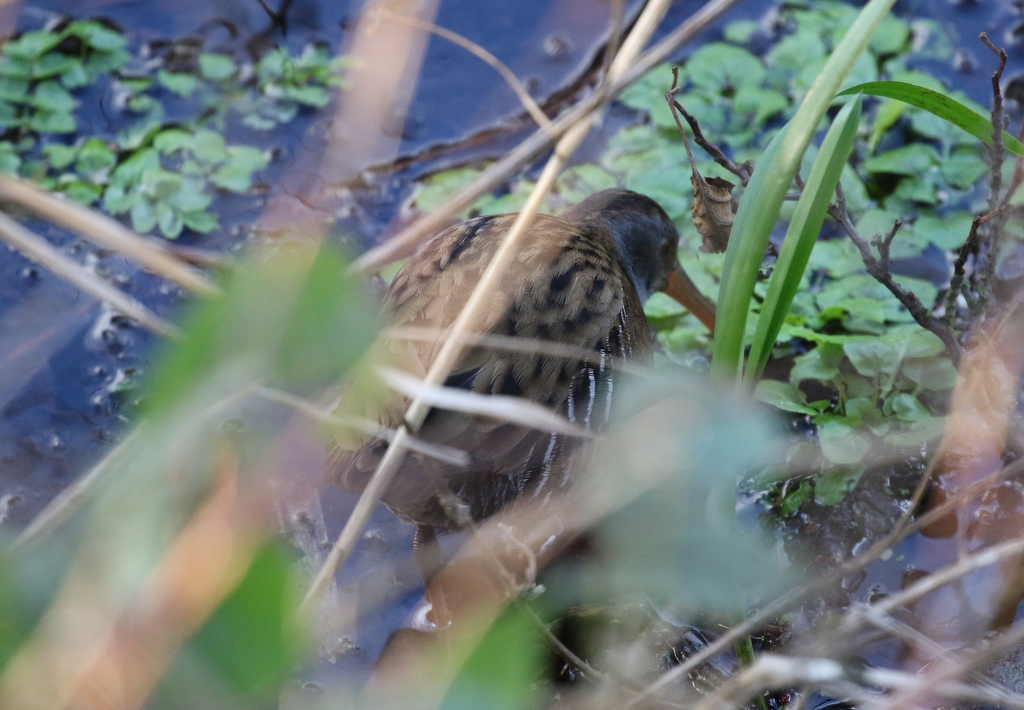
The sun was out as we walked along the path by the reedbed. It almost felt for a moment as if the forecast of rain later might be too pessimistic. The reedbed pool produced Gadwall and Tufted Duck, and we could see a single Grey Plover and a Curlew on Lavendar Marsh, but was otherwise fairly quiet, so we continued out to Parrinder Hide.
The Freshmarsh is very full of water at the moment, so there are not many places for waders here currently. There were a few Lapwings and a little group of Dunlin on the small remaining muddy island by the junction to the hide. Scanning through the ducks on the bigger, drier fenced-off island we were struck by the lack of Golden Plovers today – they must all have been feeding in the fields inland. Well, almost all, as we eventually found just a single one pretending to be a Wigeon.
There has been a Water Pipit regularly on this island, but it can be very elusive in the vegetation. Thankfully today, we found it pretty quickly, feeding on the spit on the front edge.
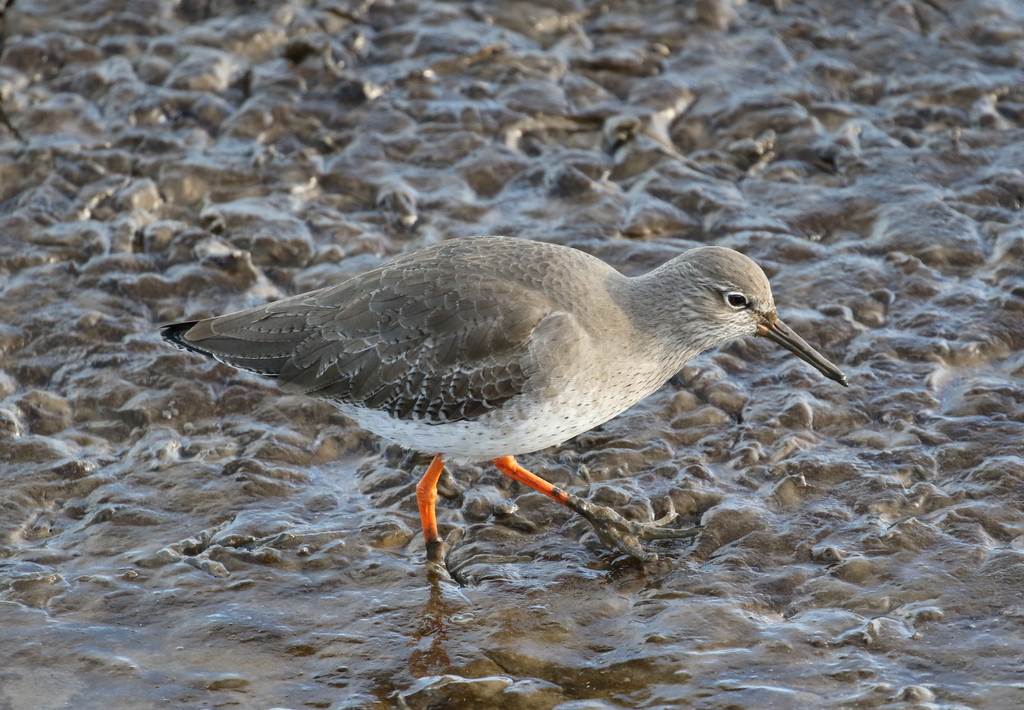
With not much else on here, we decided to head straight out to the beach. Apart from a few Redshanks and a couple of Grey Plover, there wasn’t much to see on Volunteer Marsh either. The now non-tidal ‘Tidal Pools’ are very full of water after last weeks high tides, which means there is very little island space left for roosting waders. There had apparently been some Knot on here earlier, but all we could find now was Oystercatchers and Bar-tailed Godwits, along with a small number of Dunlin and a couple more Grey Plovers.
The sea has been very productive at Titchwell in recent weeks and was one of the main reasons for coming here today, but when we got to the dunes one of the reserve volunteers was just leaving and told us there wasn’t much out there. He wasn’t wrong. All we could see on the sea was a single Common Scoter. We could see some cloud building from the west, and it started to spit with rain, so we decided to cut our losses. On the walk back to the car, the raft of Common Pochard and Tufted Duck which hadn’t been on the Freshmarsh on our way out had now reappeared.
We did a quick loop inland via Choseley on our way to Thornham, but the hedges along the side of the road here were quiet again, as they had been at the weekend. We decided to stop for lunch at Thornham Harbour and try for the Twite. While we were eating, the Twite first flew up and landed on the fence by the old sluice gate, then flew in over the saltmarsh and over to the coal barn, where they landed on the roof. After a couple of minutes they flew back in past us and landed down by the puddles in the car park for a drink, where we finally got a good look at them.
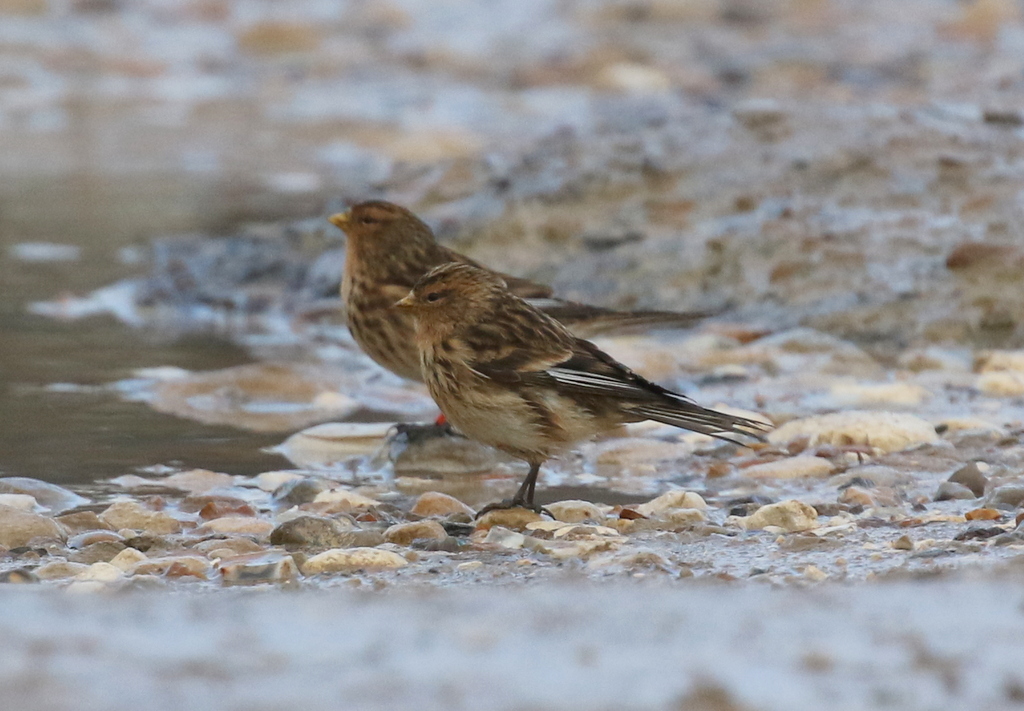
After lunch, we headed round to Holme. As we drove down the track towards the Firs, we could see a photographer with a long lens pointing it into one of the gardens, his car abandoned in the middle of the road with the door still open. As we passed, we looked across to see what he was trying to photograph and saw a Barn Owl on a pile of brash in the back garden. A couple of Mistle Thrushes were in one of the trees on the other side of the road.
When the seaduck are not at Titchwell, Holme can be a good place to look instead. As we got down to the beach, there didn’t seem to be much offshore at first, apart from a trawler being followed by a huge mob of hungry gulls. As we scanned across, we first found a few Great Crested Grebes out on the water. Then we picked up some Eider a bit further offshore, which helpfully started to fly in much closer after the trawler had passed, lots of females, several 1st winter drakes and one or two very smart adult drakes.
A paler bird caught the light a bit further out, on the sea away to the east. It didn’t look like a gull and when it surfaced again from behind the waves we could see it was a drake Long-tailed Duck, one of the birds we were hoping to see today.
There were more waders on the beach here, over towards Thornham Harbour, with a small group of Knot in with the Grey Plover and Dunlin. It had brightened up again while we were at Holme, but now we could see some very dark clouds heading our way. We got back to the car, just as it started to rain.
Our next destination was Snettisham. As we got out onto the seawall, the tide was well out. There was a big flock of Golden Plover out on the mud, and a large huddle of Oystercatchers on the beach away to the north. More waders scattered liberally around, mostly Bar-tailed Godwit, Grey Plover and Dunlin. But it was raining hard now and windy and exposed up here, so we couldn’t spend long standing and scanning without risking getting very wet.
We had come here mainly to try to see the Smew which has been at Snettisham on and off for several weeks now. It can disappear at times, but thankfully today it was on the first pit just south of the cross bank, diving with three drake Goldeneye. We had a quick look at it – it was a bit more sheltered on the inland side of the seawall – and then continued on down towards the hide.
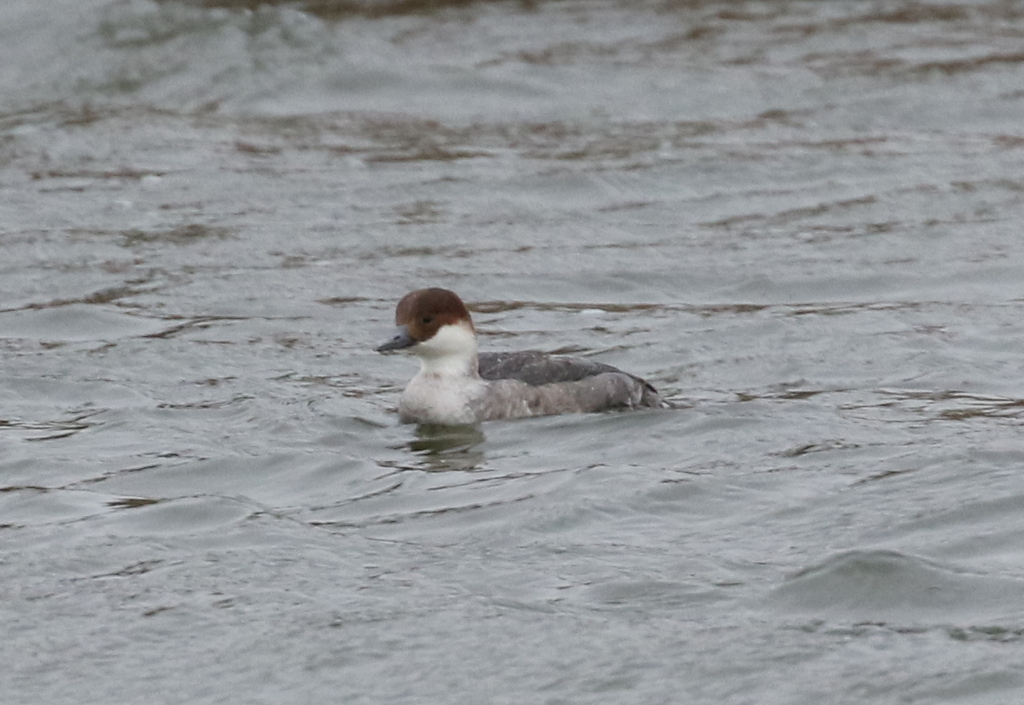
The Short-eared Owl, which had gone missing at the weekend, was apparently back under its usual bramble bush yesterday, so we made our way round to see if we could see it. Sure enough, there it was. It looked a bit bedraggled in the rain, and we were in danger of becoming the same, so with our mission here accomplished we made a swift retreat. Still, it meant we had racked up three different owls on our travels today.
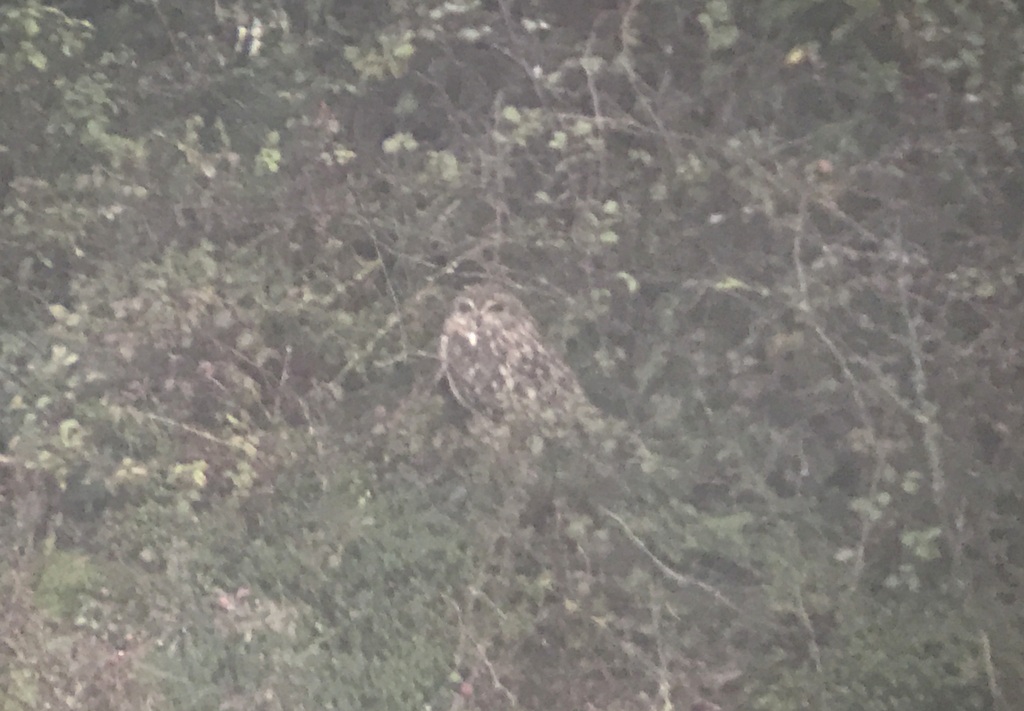
Back in the car, we made our way back east inland. We made a quick stop by a field with a strip planted with seed mix. We were looking mainly for Yellowhammers, and could see lots of birds in the hedge right at the back. They were mainly Reed Buntings, but as we scanned through them we found several Yellowhammers in with them. Even in the gloomy conditions, the bright yellow males really stood out.
Then we spotted a Tree Sparrow too. It dropped straight down out of sight, but as we scanned back we found a second Tree Sparrow a bit further back which stayed put until we all got a look at it. We could see the black spot on its white cheek. Not a great view in the driving rain, but a real bonus and not one we were expecting to get today.
There were a few common farmland birds which we had missed on our way out, so we had a look to see if we could find them on the way back, cutting across back to the coast road at Holkham. But it was a bit of a struggle to find much in the rain now. A quick stop back at Holkham was more productive though. Having drawn a blank on Great White Egret this morning, we found four together out on the grazing marshes this afternoon. For what was not that long ago a rarity in the UK, four together is quite a sight (well, away from Somerset at least)!
We had planned to finish the day at one of the raptor roosts, but when we got there the conditions were really dreadful. It was getting dark, but the driving rain meant visibility was much worse than it should have otherwise been. We headed for shelter and were told by the two people already there that they had just seen a male Hen Harrier land out on the marshes. Unfortunately they couldn’t find it again now – they couldn’t even find the post it was next to at first!
Thankfully, as we scanned across trying to find it, we spotted a harrier fly up at the back of the saltmarsh. It was not the male, but it was a ringtail Hen Harrier. We could see the flash of the white square at the base of its tail. It landed again and we could just make it out, perched on the ground.
That was more than we thought we would see, given the conditions, so we decided to call it a day. When we got back to the warm and dry, we tallied up the day’s list. 100 species! Not bad at all for a mid-winter day, and even more so given the conditions this afternoon. It just goes to show…




